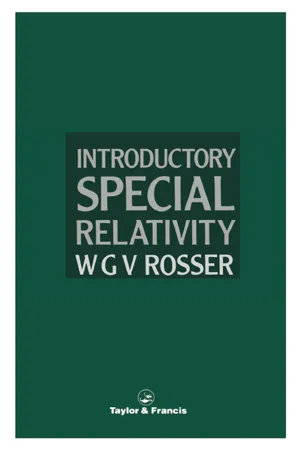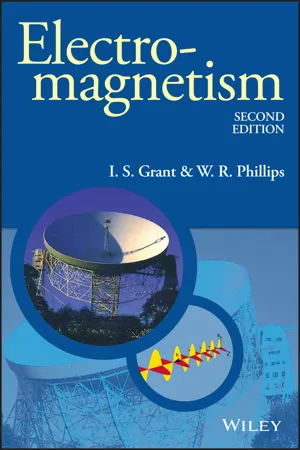Physics
Lorentz Force Law
The Lorentz Force Law describes the force experienced by a charged particle moving through an electric and magnetic field. It states that the total force on the particle is the sum of the electric force and the magnetic force acting on it. Mathematically, the Lorentz Force Law is expressed as F = q(E + v x B), where F is the force, q is the charge, E is the electric field, v is the velocity, and B is the magnetic field.
Written by Perlego with AI-assistance
Related key terms
Related key terms
1 of 4
Related key terms
1 of 3
5 Key excerpts on "Lorentz Force Law"
- eBook - ePub
- Anupam Garg(Author)
- 2012(Publication Date)
- Princeton University Press(Publisher)
11 Motion of charges and moments in external fieldsWith this chapter we carry out the second part of the program indicated in chapter 1 , namely, the motion of charges in specified E and B fields. Throughout, we ignore the energy radiated by these charges when their motion involves acceleration. In addition to charges, we also consider the motion of point magnetic moments, or spins, which are fundamental properties of many particles, atoms, ions, etc.Since the Lorentz Force Law is relativistically correct, a large portion of the analysis in this chapter is relativistically correct. We will not see the relativistic transformation of the electromagnetic fields until chapter 24 , however, so although we mention these transformations, we will not make any real use of them. We need only the relativistic relationship between the momentum, energy, and velocity of a particle, which we expect readers to have seen before. Explicit Lorentz transformations will not be invoked.68 The Lorentz Force Law
A point charge q in an external electromagnetic field E (r , t ) and B (r , t ) moves according to the Lorentz Force Law,Here, p is the momentum of the particle, and v its velocity. The fields are evaluated at the position of the particle.Equation (68.1) is relativistically correct as written. For a nonrelativistic particle, i.e., one whose speed υ is much less than the speed of light,where m is the mass of the particle.1 If v ~ c , however, one must use the exact relationship between momentum and velocity,Similarly, the relativistically correct formulas for the energy, , in terms of the velocity or the momentum areEquations (68.3) and (68.5) also lead to the useful formulaNote that includes the rest energy, mc 2 . At low speeds, we haveand one generally subtracts off the constant term mc 2 to arrive at the familiar expression for the kinetic energy.It follows from eqs. (68.5) and (68.6) that - eBook - ePub
- W G V Rosser(Author)
- 2017(Publication Date)
- CRC Press(Publisher)
8 Electromagnetism and Special Relativity 8.1 INTRODUCTIONWhen students are taught electromagnetism for the first time, it is inevitable that the individual laws such as Coulomb’s law, Ampère’s circuital law and Faraday’s law of electromagnetic induction are introduced separately. As a result, many students tend to think of these laws as describing completely independent phenomena, and very few are aware of even the relative orders of magnitude of the electric and magnetic forces between moving charges, let alone the intimate connection between the electric and magnetic forces between moving charges.In Section 8.2 the ratio of the electric to the magnetic forces in a simple case will be calculated using formulae familiar to most first-year undergraduates. The example will then be discussed in Section 8.3 , taking Coulomb’s law and the transformations of the theory of special relativity as axiomatic. This will illustrate the unity of electromagnetism in a vivid way, and show that the theory of classical electromagnetism is consistent with the theory of special relativity. The field transformations for E and B will be derived in Section 8.4 from the assumption that the expression for the Lorentz force, given by equation (2.24) , is valid in all inertial reference frames. After deriving the expressions for the electric and magnetic fields due to a charge moving with uniform velocity in Section 8.5 , we shall go on in Section 8.6 to show that Maxwell’s equations are Lorentz-covariant; that is, they obey the principle of relativity when the coordinates and time are transformed using the Lorentz transformations.8.2 FORCES BETWEEN TWO PARALLEL CONVECTION CURRENTSConsider two infinitely long, straight, thin, uniformly charged, non-conducting wires a distance r apart in vacuum lying in the (x,y) plane of an inertial reference frame ∑. Let both wires move in the positive x direction with uniform velocity ν relative to ∑, as shown in Fig. 8.1 . Let the electric charge per unit length on the wires be λ, measured relative to ∑. Since the wires are moving relative to ∑, the charge distributions give rise to convection currents relative to ∑. The charge passing any point in unit time is λυ, so that the magnitude of the convection currents is λυ - eBook - ePub
- Serhii Stepanov(Author)
- 2018(Publication Date)
- De Gruyter(Publisher)
We will return to this fact in the next volume when using Coulomb’s law (5.2) to find the force exerted by a charge moving with velocity v. We will also discover a specific force component which can be identified as a magnetic field. Finally we will obtain Maxwell’s equations and deduce classical electrodynamics, which is really based “only” on Coulomb’s law and the Lorentz transformations. 5.3 Motion in electric fields Consider the following dynamic equation describing a relativistic particle moving in a constant force field: d d t m u 1 − u 2 = F = c o n s t. In particular, such a force acts on a charge q moving in a constant electric field (Volume 2). Despite its simplicity, this equation has rather cumbersome solutions in relativistic dynamics. After integrating the equation, we obtain: u 1 − u 2 = w 0 + a t, (5.13) where a = F / m is a constant vector (simply a constant, not a three-acceleration!) and w 0 is an integration constant. The latter can be expressed in terms of the initial velocity u 0 of the object at t = 0: w 0 = u 0 1 − u 0 2. Squaring (5.13) and expressing u 2 in terms of the time, we have u (t) = w 0 + a t 1 + (w 0 + a t) 2. (5.14) By definition, u (t) = d r / dt, so the law of motion of a particle is obtained by integrating the. function u (t): r (t) = ∫ u (t) d t = σ a ∫ w 0 + a t 1 + σ 2 (t + w 0 a a 2) 2 d t, where we have completed the square in (w 0 + a t) 2 = w 0 2 + 2 w 0 a t + a 2 t 2 (⋖ H 21) with respect to t, a = | a |, and the following constant was. introduced σ = a 1 + [ w 0 × a ] 2 a 2. Making the change of variables τ = t + (w 0 a)/ a 2, we obtain: r (t) = σ a ∫ a τ + [ a × [ w 0 × a ] ] a 2 1 + σ 2 τ 2 d τ, where a vector triple product formula was used. Using the tabulated. integrals ∫ τ d τ 1 + σ 2 τ 2 = 1 σ 2 1 + σ 2 τ 2, ∫ τ d τ 1 + σ 2 τ 2 = 1 σ 2 ln (σ τ + 1 + σ 2 τ 2), which can be verified directly by differentiation, we - eBook - ePub
- I. S. Grant, W. R. Phillips(Authors)
- 2013(Publication Date)
- Wiley(Publisher)
This four-vector is defined by Equations (14.24) and (1.29) for any distribution of charge and current density, and it is not restricted to charges which are all moving with the same velocity. However, after removing this restriction it is not possible to prove that the force on a charge q is still given by Equation (14.22). From the starting-point of Coulomb’s law the Lorentz transformation cannot by itself tell us about the interaction of charges in relative motion. But let us now assume that Equation (14.22) holds in general, with B = curl A. Does the force then have the correct properties when it undergoes a Lorentz transformation? The answer to this question, which was discussed in section 14.6, is yes, provided that a time-dependent term is added to the electric field, which must become E = − grad ϕ − ∂ A /∂ t. This is Faraday’s law, since To sum up, after making a Lorentz transformation of electrostatic forces, a simple generalization leads very persuasively to the other laws governing the forces between charged particles. There is a sense, then, in which Coulomb’s law can be regarded as fundamental, with magnetic forces and induced e.m.f.s appearing as relativistic side-effects. Yet one ought not to attach too much importance to the philosophical game of choosing the neatest set of initial postulates as the basis of electromagnetism. The real test of a physical theory comes in comparing its predictions with observation. On this criterion electromagnetism is extraordinarily successful; as we pointed out at the beginning of this book, when quantum effects have been taken into account, no accurate observation has ever detected the slightest deviation from the theoretical predictions. 14.8 RETARDED POTENTIALS FROM THE RELATIVISTIC STANDPOINT A general solution of Maxwell’s equations in the absence of dielectric and magnetic media was given in Chapter 13 in terms of retarded scalar and vector potentials - eBook - ePub
- A.P. French(Author)
- 2017(Publication Date)
- CRC Press(Publisher)
B to the statement of the force law. And this is precisely how the equations are written in what is traditionally called the CGS system—although, as mentioned at the beginning of the chapter, the essential point is not the choice of units as such but the use of Coulomb’s law, rather than the force between currents, to define a unit of charge. Thus in the CGS system the two equations above are replaced by the following:( CGS system )}whereF 12=q 2( ε +u c× B )B =v c× εThe magnetic field is thus defined, in effect, as some fraction (≈ υ /c ) of the electric field. We see, then, how it comes about that in the magnetic force law,F mag= const .(q 2u × B )the value of the constant should be unity according to a system (MKS) in which unit charge is defined in terms of the force between currents, but equal to 1/c according to a system (CGS) in which the unit charge is defined in terms of Coulomb’s law.It is apparent that the CGS system has much to commend it from the standpoint of the lack of any fundamental distinction between electric and magnetic forces. But whichever system one uses, the results that we have developed make it possible to formulate a set of transformation equations between components of ε or B in one frame and related components of both ε and B in another frame. They will be a set of linear equations, essentially similar to the original Lorentz transformations that mingle distance and time, or the dynamical transformations that mingle momentum and energy. You can easily develop them if you choose. But their general application would be outside the scope of this book.Problems
8–1 Consider the situation in the figure. Show, by transforming into the rest frame of q 1 and then back into the laboratory frame, that the force on the test charge q 2 is the same whether the source charge q 1 is moving toward q 2
Index pages curate the most relevant extracts from our library of academic textbooks. They’ve been created using an in-house natural language model (NLM), each adding context and meaning to key research topics.
Explore more topic indexes
Explore more topic indexes
1 of 6
Explore more topic indexes
1 of 4




